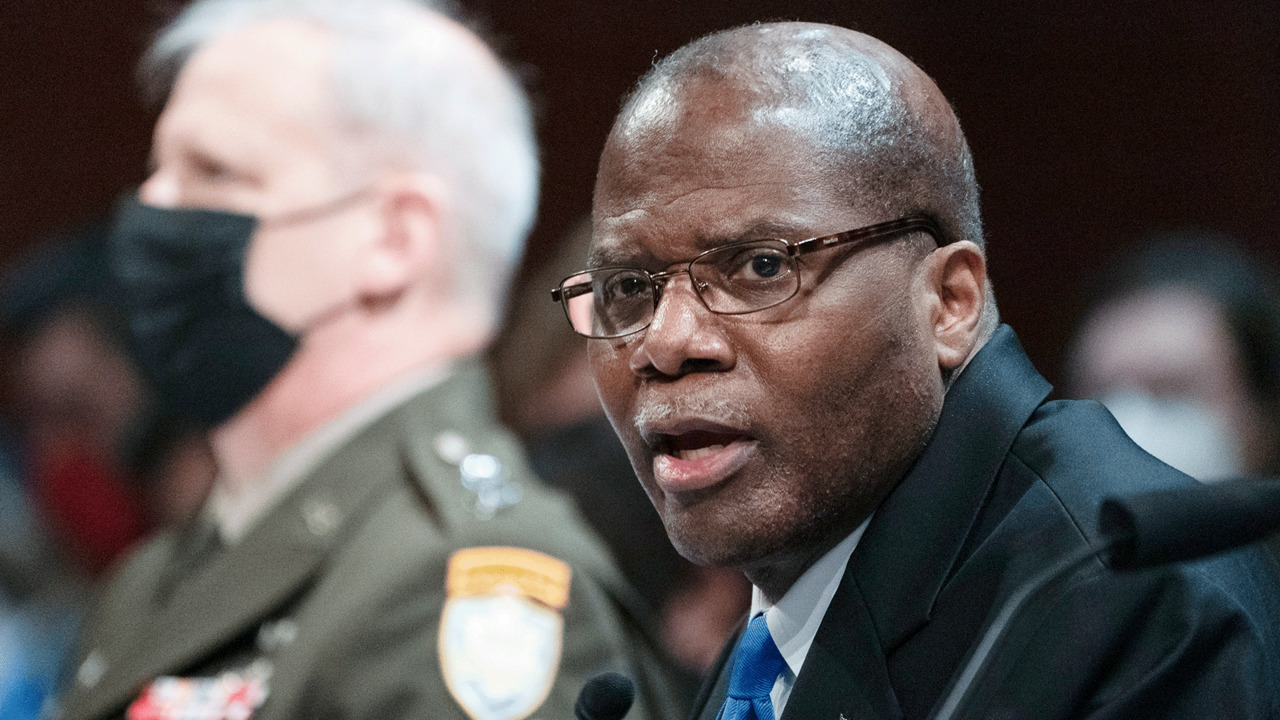Pentagon getting more UFO reports now that ‘stigma has been reduced’

Some have also come dangerously close to U.S. aircraft, Bray testified. “We have not had a collision. We’ve had at least 11 near misses, though,” he told Rep. Raja Krishnamoorthi, a Democrat from Illinois.
The updated numbers, which also include some historical cases that have recently emerged, are more than double what was reported in a preliminary report to Congress last June that identified 144 UAPs, including 18 that maneuvered in ways that seemed to defy known aerodynamics.
The details came in a rare public session in which top U.S. intelligence officials were pressed to reveal what they know about the highly secretive and controversial mystery. The hearing covered widely held conspiracies that the government has obtained material from crashed UFOs (they said they haven’t) and whether they have studied high-profile UFO cases such as one that reportedly shut down nuclear missiles in Montana decades ago (they have not and promised to look into it).
The hearing came amid an internal feud over how much to share with the public, and as lawmakers have criticized intel agencies for being less than forthcoming on what they have learned so far.
‘Not been done before’
Ronald Moultrie, DoD’s undersecretary of intelligence, vowed to apply “rigorous scientific analysis” to studying the origin of UAPs through the Pentagon’s recently established Airborne Object Identification and Management Synchronization Group.
“A methodical approach is something we are doing that has not been done before,” he said.
Asked by subcommittee Chair Rep. André Carson (D-Ind.) if the Pentagon will follow the facts wherever they may lead, Moultrie responded, “we’re open to all hypotheses, we’re open to any conclusions that we may encounter.”
He also described his own curiosity of the unknown and the potential implications of solving some of the UAP mysteries, including a lighthearted revelation that he has attended sci-fi conventions.
“I enjoy the challenge of what may be out there,” Moultrie said. “I have followed science fiction. I have gone to conventions even. I’ll say it on the record. But there’s nothing wrong with that. Don’t necessarily dress up, but I do believe that it’s important to show that the Department of Defense … we have character and we’re people just like you, just like the American people.”
“We have our inquisitiveness, we have our questions,” he added.
New video footage
One of the more unusual moments in the hearing was when the witnesses played for the committee a cockpit video taken over a military training range of a spherical craft whooshing past in broad daylight.
“I do not have an explanation for what this specific object is,” Bray told the panel.
Asked by Rep. Adam Schiff (D-Calif.), the chair of the full committee, if data on the craft was captured by multiple sensors — and not just video — Bray declined to answer in public, deferring to a subsequent classified session.
“I think that would be more appropriately addressed in closed session,” he said.
But he did indicate the video footage wasn’t the only evidence. “In this case, we have at least that,” he said.
Moultrie also said that oftentimes military and intelligence sensors are not able to gather sufficient data. “Sometimes it’s very fleeting data that we have on some of these objects,” he said. “We want to make sure to calibrate it for things of this nature and size, things of this velocity.”
Moultrie also deferred to the classified session when asked by Rep. Rick Crawford (R-Ark.) if sensors have detected underwater or submerged UAPs.
‘We have no material’
And panel members did not shy away from pressing the witnesses on some of the more controversial theories and claims.
“Are we holding materials organic or inorganic that we don’t know about?” asked Rep. Jim Himes, a Connecticut Democrat.
“When it comes to material we have, we have no material,” Bray responded.
Rep. Mike Gallagher, who is also a member of the Armed Services Committee, got Moultrie to say on the record that he was not aware of any official UFO research effort between the Air Force’s Project Blue Book that closed down in 1969 and the short-lived Advanced Aerospace Threat Identification Program that was established in 2007.
Moultrie also told Gallagher that he was not aware of any dedicated programs to studying UAP technology outside the current effort.
“I’m not aware of any contractual programs that are focused on anything related to this, other than what we are doing in the … task force and what we are about to launch in terms of our effort,” he said.
“Not aware of anything outside of what we are doing in the UAP Task Force,” Bray also added.
Gallagher also asked about a high-profile report of a “glowing red orb” that was reportedly observed over Malmstrom Air Force Base in Montana, “in which 10 of our nuclear ICBMs were rendered inoperable.”
“I have heard stories, I have not seen official data on that,” Bray responded.
“I would like you to look into it,” Gallagher said.
“We’ll go back and take a look at it,” Bray agreed.
Gallagher also entered into the record a copy of unverified 2002 meeting notes referred to as the “Admiral Wilson memo” that purports to reveal government officials and contractors discussing how they have been blocked from accessing information about crashed UFO materials.
The claims have been hotly debated among ufologists, but never corroborated. One of the individuals cited in the document, Eric Davis, who is now a senior project engineer at government-funded Aerospace Corp., has declined several POLITICO requests for interviews.
Moultrie and Bray said they were unfamiliar with the document.
‘To reach some conclusions’
Bray explained the evolving process for compiling and analyzing UAP reports.
First, he said, “it goes through the operational chain of command … and also to the UAP Task Force so that they can take that data, database it and quite often have individuals from the task force contact the aviator and ask them additional questions if there were things that weren’t clear in the report.”
Secondly, “that thing goes into a database where we can compare it with other observations that we have — again, comparing for locations, comparing for altitudes, speeds, shapes, if any [radio frequency] emissions] were detected from the platform … so we can try to reach some conclusions on that,” he added.
In his prepared testimony, Moultrie maintained that “it is the Department’s contention that, by combining appropriately structured collected data with rigorous scientific analysis, any object that we encounter can likely be isolated, characterized, identified, and, if necessary, mitigated.”
That includes whether the reports can be explained by potential technological breakthroughs by allies or adversaries, secret U.S. vehicles or “commercial platforms,” or “natural or other phenomena.”
Moultrie also offered the committee a fairly limited definition for “unexplained aerial phenomena,” the government’s term for UFOs.
He described them as “airborne objects that, when encountered, cannot be immediately identified.” The hearing did not address reports of craft appearing to transition to and from the sea, the air and space.
Moultrie also acknowledged the “cultural stigma” surrounding UFOs has hamstrung efforts to explain the phenomena by preventing witnesses from coming forward.
“Our goal is to eliminate this stigma by fully incorporating our operators and mission personnel into a standardized data gathering process,” he said at the opening of the hearing. “We believe that making UAP reporting a mission imperative will be instrumental to this effort’s success.”
But panel members also sounded wary that the department will follow through without more aggressive oversight.
“You need to show Congress and the American public, whose imagination you have captured, you are willing to follow the facts where they lead,” Carson told the witnesses. “I fear sometimes that DoD is focused more on emphasizing what it can explain, not investigating what it can’t.”
Carson also indicated that more hearings are in the offing. “The last time Congress had a hearing on UAPs was a half-century ago,” he said. “I hope that it does not take 50 years for Congress to hold another. Because transparency is desperately needed.”
Added Schiff: “It is also the responsibility of … government and this panel to share as much as we can with the American people — since excessive secrecy only breeds distrust and speculation.”
‘Spurious chases and hunts’
On the issue of how much to share with the public, Moultrie said DoD “is fully committed to the principles of openness and accountability to the American people. However, we are also mindful of our obligation to protect sensitive sources and methods.”
“Our goal,” he added, “is to strike that delicate balance — one that will enable us to maintain the public’s trust while preserving those capabilities that are vital to the support of our service personnel.”
But that doesn’t mean chasing every UFO report, Moultrie said, asserting that military and intelligence agencies need to focus on what may be a genuine threat to security or air safety.
“One of the concerns that we have is there are a lot of individuals and groups that are putting information out there that could be considered to be somewhat self-serving,” Moultrie told Rep. Darin LaHood, a Republican from Illinois.
“Anything that diverts us off of what we have with the resources that have been allocated to,” he continued, distracts the national security agencies “on spurious chases and hunts that are just not helpful. They also contribute to the undermining of the confidence that the Congress and the American people have that we are trying to get to the root cause of what’s happening here.”
But he also insisted that the department wants to share what it can with other organizations in and out of government.
“What we don’t want to do is to bring something into a DoD database for a DoD holding and then have so many wraps around it’s not available to those who really need to look at it to exploit it,” Moultrie said.
That means relying on other government agencies for help when collecting data that falls outside the expertise of military or intelligence experts.
For example, Moultrie said “if it’s a weather phenomenology,” the Pentagon would turn to the National Oceanic and Atmospheric Administration. “If it’s a potential for extraterrestrial life or indication of extraterrestrial life [it would coordinate] with someone like NASA.”


